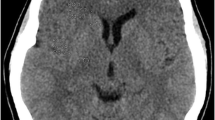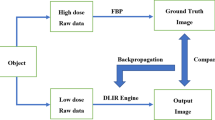Abstract
Objective
To investigate the quality of images reconstructed with adaptive statistical iterative reconstruction V (ASIR-V), using pediatric head CT protocols.
Methods
A phantom was scanned at decreasing 20% mA intervals using our standard pediatric head CT protocols. Each study was then reconstructed at 10% ASIR-V intervals. After the phantom study, we reduced mA by 10% in the protocol for <3-year-old patients and applied 30% ASIR-V and by 30% in the protocol for 3- to 15-year-old patients and applied 40% ASIR-V.
Results
Increasing the percentage of ASIR-V resulted in lower noise and higher contrast-to-noise ratio (CNR) and preserved spatial resolution in the phantom study. Compared to a conventional-protocol, reduced-dose protocol with ASIR-V achieved 12.8% to 34.0% of dose reduction and showed images of lower noise (9.22 vs. 10.73, P = 0.043) and higher CNR in different levels (centrum semiovale, 2.14 vs. 1.52, P = 0.003; basal ganglia, 1.46 vs. 1.07, P = 0.001; and cerebellum, 2.18 vs. 1.33, P < 0.001). Qualitative analysis showed higher gray-white matter differentiation and sharpness and preserved overall diagnostic quality in the images with ASIR-V.
Conclusions
Use of ASIR-V allowed a 12.8% to 34.0% dose reduction in each age group with potential to improve image quality.
Key points
• It is possible to reduce radiation dose and improve image quality with ASIR-V.
• We improved noise and CNR and decreased radiation dose.
• Sharpness improved with ASIR-V.
• Total radiation dose was decreased by 12.8% to 34.0%.




Similar content being viewed by others
Abbreviations
- ASIR:
-
Adaptive Statistical Iterative Reconstruction
- ASIR-V:
-
Adaptive Statistical Iterative Reconstruction V
- CNR:
-
Contrast-to-Noise Ratio
- CT:
-
Computed Tomography
- CTDIvol:
-
volume CT Dose Index
- DLP:
-
Dose Length Product
- FBP:
-
Filtered Back Projection
- GM:
-
Gray Matter
- HU:
-
Hounsfield Units
- MBIR:
-
Model-Based Iterative Reconstruction
- ROI:
-
Region of Interest
- SD:
-
Standard Deviation
- WM:
-
White Matter
References
Mettler FA Jr, Thomadsen BR, Bhargavan M et al (2008) Medical radiation exposure in the U.S. in 2006: preliminary results. Health Phys 95:502–507
Huda W, Vance A (2007) Patient radiation doses from adult and pediatric CT. AJR Am J Roentgenol 188:540–546
Deak PD, Smal Y, Kalender WA (2010) Multisection CT protocols: sex- and age-specific conversion factors used to determine effective dose from dose-length product. Radiology 257:158–166
Brenner DJ, Hall EJ (2007) Computed tomography--an increasing source of radiation exposure. N Engl J Med 357:2277–2284
Goske MJ, Applegate KE, Boylan J et al (2008) The Image Gently campaign: working together to change practice. AJR Am J Roentgenol 190:273–274
Silva AC, Lawder HJ, Hara A, Kujak J, Pavlicek W (2010) Innovations in CT dose reduction strategy: application of the adaptive statistical iterative reconstruction algorithm. AJR Am J Roentgenol 194:191–199
Kim HG, Chung YE, Lee YH et al (2015) Quantitative analysis of the effect of iterative reconstruction using a phantom: determining the appropriate blending percentage. Yonsei Med J 56:253–261
Deak Z, Grimm JM, Treitl M et al (2013) Filtered back projection, adaptive statistical iterative reconstruction, and a model-based iterative reconstruction in abdominal CT: an experimental clinical study. Radiology 266:197–206
Ning P, Zhu S, Shi D, Guo Y, Sun M (2014) X-ray dose reduction in abdominal computed tomography using advanced iterative reconstruction algorithms. PLoS One 9, e92568
Lim K, Kwon H, Cho J et al (2015) Initial phantom study comparing image quality in computed tomography using adaptive statistical iterative reconstruction and new adaptive statistical iterative reconstruction v. J Comput Assist Tomogr 39:443–448
Kwon H, Cho J, Oh J et al (2015) The adaptive statistical iterative reconstruction-V technique for radiation dose reduction in abdominal CT: comparison with the adaptive statistical iterative reconstruction technique. Br J Radiol 88:20150463
Bier G, Bongers MN, Ditt H, Bender B, Ernemann U, Horger M (2016) Enhanced gray-white matter differentiation on non-enhanced CT using a frequency selective non-linear blending. Neuroradiology. doi:10.1007/s00234-016-1674-1
Kilic K, Erbas G, Guryildirim M, Arac M, Ilgit E, Coskun B (2011) Lowering the dose in head CT using adaptive statistical iterative reconstruction. AJNR Am J Neuroradiol 32:1578–1582
Boone JM SK, Cody DD (2011) Size-specific dose estimates (SSDE) in pediatric and adult body CT examinations. American Association of Physicists in Medicine. AAPM Report No. 204
Vorona GA, Zuccoli G, Sutcavage T, Clayton BL, Ceschin RC, Panigrahy A (2013) The use of adaptive statistical iterative reconstruction in pediatric head CT: a feasibility study. AJNR Am J Neuroradiol 34:205–211
Rapalino O, Kamalian S, Kamalian S et al (2012) Cranial CT with adaptive statistical iterative reconstruction: improved image quality with concomitant radiation dose reduction. AJNR Am J Neuroradiol 33:609–615
Hara AK, Paden RG, Silva AC, Kujak JL, Lawder HJ, Pavlicek W (2009) Iterative reconstruction technique for reducing body radiation dose at CT: feasibility study. AJR Am J Roentgenol 193:764–771
McKnight CD, Watcharotone K, Ibrahim M, Christodoulou E, Baer AH, Parmar HA (2014) Adaptive statistical iterative reconstruction: reducing dose while preserving image quality in the pediatric head CT examination. Pediatr Radiol 44:997–1003
Mirro AE, Brady SL, Kaufman RA (2016) Full Dose-Reduction Potential of Statistical Iterative Reconstruction for Head CT Protocols in a Predominantly Pediatric Population. AJNR Am J Neuroradiol 37:1199–1205
Hwang JY, Do KH, Yang DH et al (2015) A Survey of Pediatric CT Protocols and Radiation Doses in South Korean Hospitals to Optimize the Radiation Dose for Pediatric CT Scanning. Medicine (Baltimore) 94, e2146
Takei Y, Miyazaki O, Matsubara K et al (2016) Nationwide survey of radiation exposure during pediatric computed tomography examinations and proposal of age-based diagnostic reference levels for Japan. Pediatr Radiol 46:280–285
Komlosi P, Zhang Y, Leiva-Salinas C et al (2014) Adaptive statistical iterative reconstruction reduces patient radiation dose in neuroradiology CT studies. Neuroradiology 56:187–193
Vachha B, Brodoefel H, Wilcox C, Hackney DB, Moonis G (2013) Radiation dose reduction in soft tissue neck CT using adaptive statistical iterative reconstruction (ASIR). Eur J Radiol 82:2222–2226
Healthcare GE (2011) Veo user manual and technical reference manual. General Electric, Waukesha, WI
Acknowledgements
We thank Min Jeong Yun of GE Healthcare Korea, for technical assistance.
Author information
Authors and Affiliations
Corresponding author
Ethics declarations
Guarantor
The scientific guarantor of this publication is Myung-Joon Kim.
Conflict of interest
The authors of this manuscript declare no relationships with any companies, whose products or services may be related to the subject matter of the article.
Funding
The authors state that this work has not received any funding.
Statistics and biometry
One of the authors has significant statistical expertise. (Hyun Ji Kim)
Ethical approval
Institutional Review Board approval was obtained.
Informed consent
Written informed consent was waived by the Institutional Review Board.
Methodology
Retrospective
Cross sectional study
Performed at one institution
Rights and permissions
About this article
Cite this article
Kim, H.G., Lee, HJ., Lee, SK. et al. Head CT: Image quality improvement with ASIR-V using a reduced radiation dose protocol for children. Eur Radiol 27, 3609–3617 (2017). https://doi.org/10.1007/s00330-017-4733-z
Received:
Revised:
Accepted:
Published:
Issue Date:
DOI: https://doi.org/10.1007/s00330-017-4733-z




